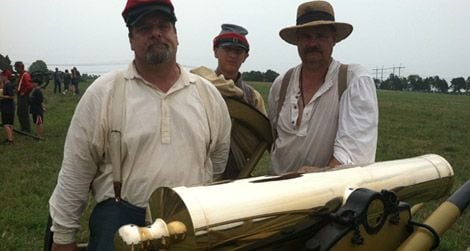Seven Obscure Facts You Didn’t Know About the Civil War
Amid the vast literature of the Civil War, it’s easy to lose sight of some of the stranger facts, coincidences and quirks of character
/https://tf-cmsv2-smithsonianmag-media.s3.amazonaws.com/filer/c5/df/c5df48c3-d3bd-4719-acf9-ccfd52ade4f1/rectal-acorn-500-375.jpg)
Gertrude Stein said it best: “There will never be anything more interesting in America than that Civil War.” And of course interest is high, now that we’ve begun commemorating the sesquicentennial anniversaries of the war’s key events. For the First Battle of Bull Run (or Manassas, to Southerners) last July, re-enactors descended upon Gainesville, Virginia, from as far afield as Germany, Uruguay and Hawaii.
Even with the war’s vast bibliography—more than 60,000 books have been published since the last shot was fired, in June 1865—some of the odder coincidences and bizarre facts of the period are overlooked. Wilmer McLean became one of the legendary figures of the war merely by trying to escape it. (After his house was shelled in a skirmish preceding the First Battle of Bull Run, he moved—to Appomattox Court House, where General Lee surrendered to General Grant.)
Here are some other noteworthy people and artifacts:
• The Unusual Bunker Brothers. Chang and Eng Bunker are best known as “the original Siamese Twins.” Natives of Siam (modern Thailand) and joined at the sternum, they became a popular attraction with traveling museum exhibitions.In 1839, they bought 110 acres in the Blue Ridge Mountains in North Carolina and settled down. They married sisters, built a successful farm (with slave labor) and became naturalized citizens and devoted Confederates. In 1865, Union General George Stoneman raided North Carolina and decided to draft some of the locals, regardless of sympathies; the names of men over 18 were put into a lottery wheel. Eng’s name was drawn, but he resisted the draft. Since Chang’s name was not drawn, there was little General Stoneman could do; the brothers were not only joined at the sternum, their livers were fused. Neither one served in the war, but their eldest sons both enlisted and fought for the Confederacy.

• The secret hiding place. In 2009, a woman visited the Museum of the Confederacy in Richmond, Virginia, with an acorn-shaped object in hand. It was made of brass and had no inscriptions or markings. She said that according to family lore, one of her ancestors, a Confederate soldier, used the device to smuggle secret messages, hiding it in his posterior until he reached his destination. Museum officials were intrigued by what she called a “rectal acorn,” but she declined to donate it.
• Mourning rituals. Wartime convention decreed that a woman mourn her child’s death for one year, a brother’s death for six months, and a husband’s death for two and a half years. She progressed through prescribed stages of heavy, full, and half mourning, with gradually loosening requirements of dress and behavior. Mary Todd Lincoln remained in deep mourning for more than a year after her son Willie’s death, dressing in black veils, black crepe and black jewelry. Flora Stuart, the widow of Confederate General J.E.B. Stuart, remained in heavy morning for 59 years after the 1864 death of her husband, wearing black until she died in 1923. By contrast, a widower was expected to mourn for only three months, simply by displaying black crepe on his hat or armband.
• Glowing wounds. After the Battle of Shiloh in 1862, soldiers reported a peculiar phenomenon: glow-in-the-dark wounds. More than 16,000 soldiers from both armies were wounded during the battle, and neither Union nor Confederate medical personnel were prepared for the carnage. Soldiers lay in the mud for two rainy days, and many of them noticed that their wounds glowed in the dark. In fact, the injured whose wounds glowed seemed to heal better than the others. In 2001, two Maryland teenagers solved the mystery (and won a top prize at an international science fair). The wounded became hypothermic, and their lowered body temperatures made ideal conditions for a bioluminescent bacterium called Photorhabdus luminescens, which inhibits pathogens.
• The other Jefferson Davis. Union General Jefferson Davis shared a name with the Confederate president, a circumstance that didn’t cause as much confusion as might be expected—with one notable exception. During the Battle of Chickamauga in 1863, as darkness fell on Horseshoe Ridge, members of the 21st Ohio saw a swarm of men approaching but couldn’t tell if they were friend or foe. Most assumed they were Union reinforcements, but a few feared they were Confederates. As the troops grew closer, one Union soldier called out, “What troops are you?” The collective reply was “Jeff Davis’s troops.” The Ohio soldiers relaxed, believing they meant the Union general. A few moments later, they were staring down the muzzles and bayonets of the 7th Florida. The Ohioans surrendered. The Confederates won the battle.
/https://tf-cmsv2-smithsonianmag-media.s3.amazonaws.com/filer/d1/53/d153767b-a2e3-4690-b06c-9589fa85b23d/stonewall-537-640.jpg)
• The Things He Carried. After President Abraham Lincoln died, on April 15, 1865, his leather wallet was found to contain a $5 Confederate bill, imprinted with the image of Confederate President Jefferson Davis. Lincoln may have gotten the bill when he visited Petersburg and Richmond earlier in the month.
Editor's note, January 10, 2019: This story originally had eight facts, but after hearing from historian Adam Domby on Twitter, we removed one of them for presenting a fabulist's story as truth. We regret including the misinformation in the original post.
SOURCES
Books: Andrew Ward. The Slaves’ War: The Civil War in the Words of Former Slaves. Boston: Houghton Mifflin, 2008; Derek Smith. The Gallant Dead: Union and Confederate Generals Killed in the Civil War. Mechanicsburg, PA: Stackpole Books, 2005; Archibald Gracie. The Truth About Chickamauga. Boston: Houghton Mifflin, 1911; Burke Davis. The Civil War: Strange and Fascinating Facts. New York: Fairfax Press, 1960; Drew Gilpin Faust. This Republic of Suffering: Death and the American Civil War. New York: Alfred A. Knopf, 2008.
Articles: “Mystery of Glowing Wounds Solved,” by Linda Searing. HealthScout News, June 11, 2001.
/https://tf-cmsv2-smithsonianmag-media.s3.amazonaws.com/accounts/headshot/karen.png)
/https://tf-cmsv2-smithsonianmag-media.s3.amazonaws.com/accounts/headshot/karen.png)